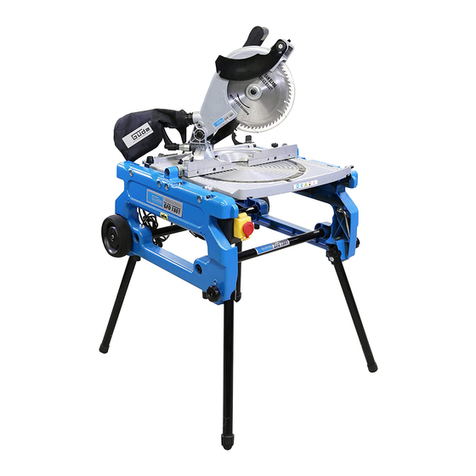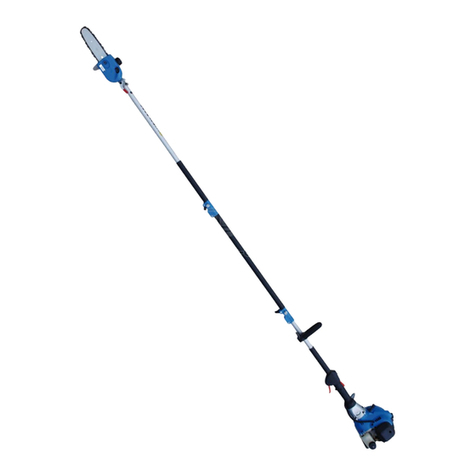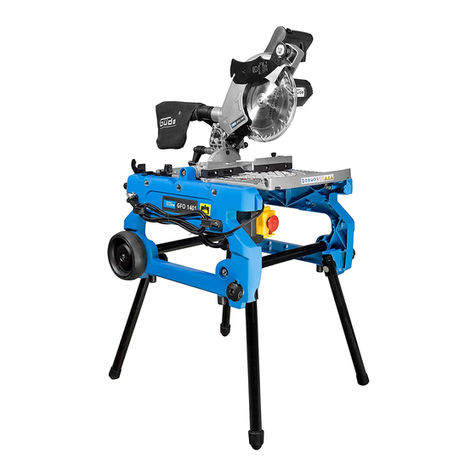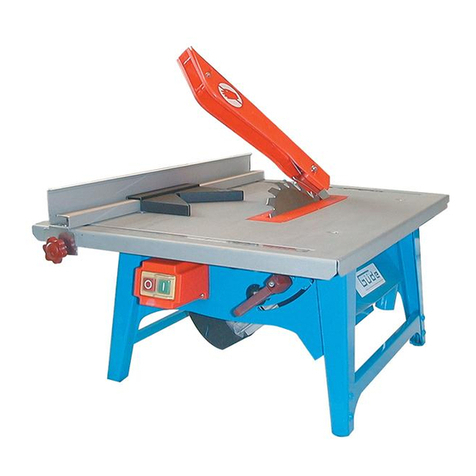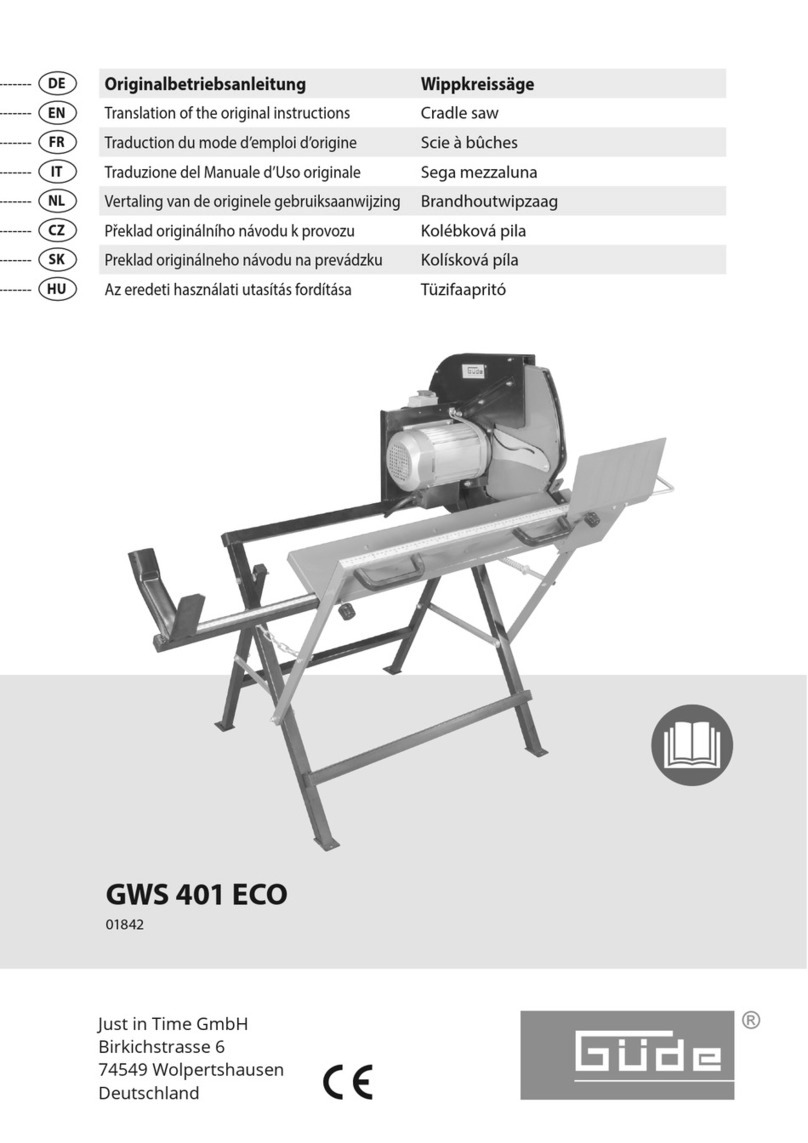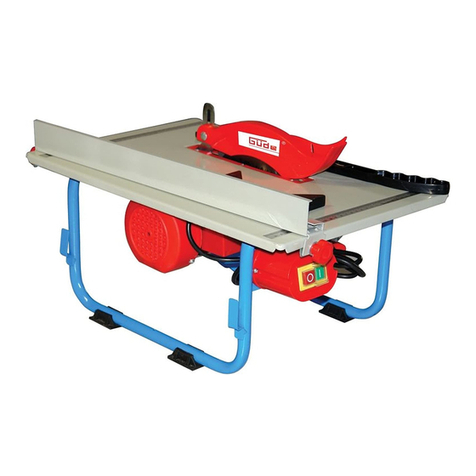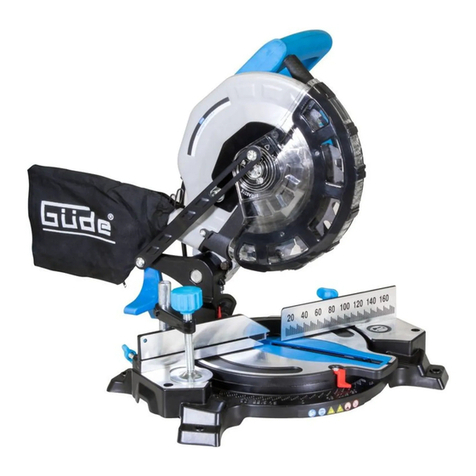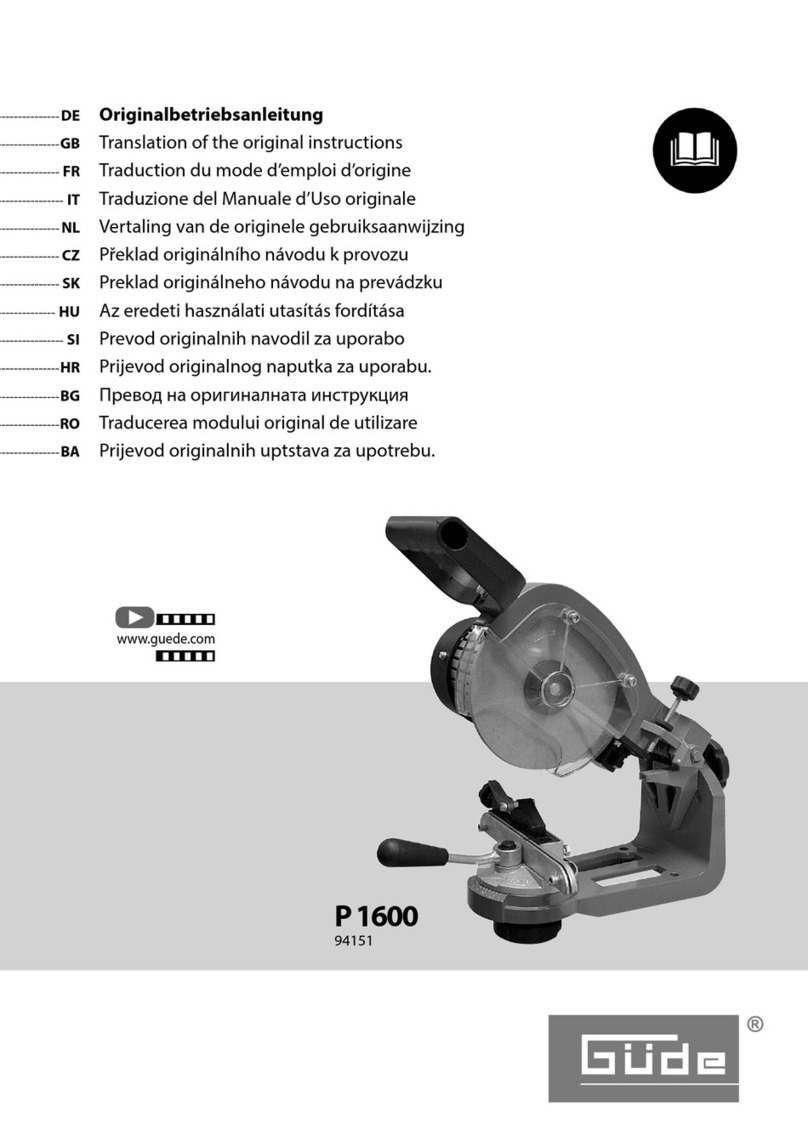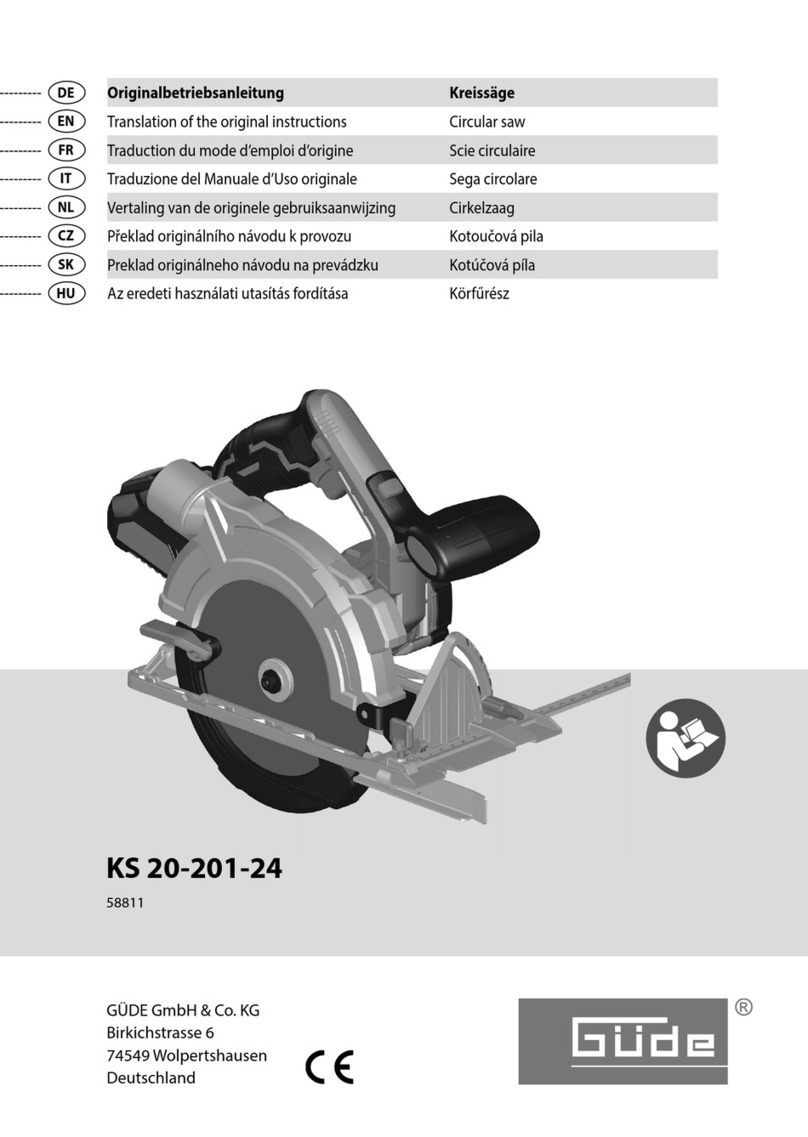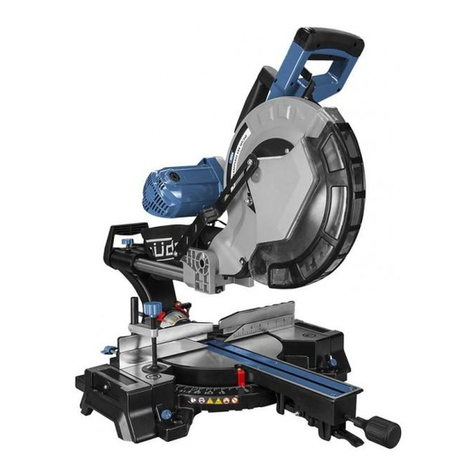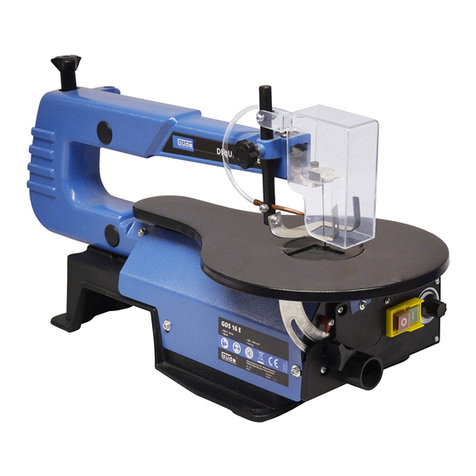
Gewährleistung
Die Gewährleistung erstreckt sich ausschließlich auf
Mängel, die auf Material- oder Herstellungsfehler
zurückzuführen sind. Bei Geltendmachung eines Mangels
im Sinne der Gewährleistung ist der original Kaufbeleg mit
Verkaufdatum beizufügen.
Von der Gewährleistung ausgeschlossen sind
unsachgemäße Anwendungen, wie z. B. Überlastung des
Gerätes, Gewaltanwendung, Beschädigungen durch
Fremdeinwirkung oder durch Fremdkörper.
Nichtbeachtung der Gebrauchs- und Aufbauanleitung und
normaler Verschleiß sind ebenfalls von der
Gewährleistung ausgeschlossen.
Technische Daten
Motorleistung: 250 Watt S2 15 min
Anschluss: 230 V/50 Hz
Sägebandgeschwindigkeit: 15,7 m/sek.
Sägebandlänge: 1400 mm
Sägebandrollen: 205 mm
Max. Durchlasshöhe: 80 mm
Max. Durchlassbreite: 190 mm
Tischgröße: 300 x 300 mm
Gewicht: ca.20 kg
Allgemeine Sicherheitshinweise
Die Bedienungsanleitung muss vor der ersten
Anwendung des Gerätes ganz durchgelesen werden.
Falls über den Anschluss und die Bedienung des
Gerätes Zweifel entstehen sollten, wenden Sie sich an
den Hersteller (Service-Abteilung).
UM EINEN HOHEN GRAD AN SICHERHEIT ZU
GARANTIEREN, BEACHTEN SIE AUFMERKSAM
FOLGENDE HINWEISE:
ACHTUNG!
•Halten Sie den Arbeitsbereich sauber und
aufgeräumt. Unordentliche Arbeitsplätze und
Werkbänke erhöhen die Gefahr von Unfällen und
Verletzungen.
•Achten Sie auf die Umgebungsbedingungen,
unter denen Sie arbeiten. Verwenden Sie keine
Elektrowerkzeuge und Werkzeugmaschinen in
feuchter oder nasser Umgebung. Sorgen Sie für
ausreichend Beleuchtung. Setzen Sie elektrische
Werkzeuge nicht dem Regen oder hoher
Luftfeuchtigkeit aus. Schalten Sie elektrische
Werkzeuge nicht in einer Umgebung mit leicht
entflammbaren Flüssigkeiten oder Gasen ein.
•Lassen Sie keine Fremden an die Maschine.
Besucher und Zuschauer, vor allem Kinder sowie
kranke und gebrechliche Personen, sollten vom
Arbeitsplatz fern gehalten werden.
•Sorgen Sie für die sichere Aufbewahrung von
Werkzeugen. Werkzeuge, die nicht gebraucht
werden, müssen an einem trockenen, möglichst hoch
gelegenen Platz aufbewahrt oder unzugänglich
verwahrt werden.
•Verwenden Sie für jede Arbeit immer das richtige
Werkzeug. Verwenden Sie z.B. keine
Kleinwerkzeuge oder Zubehör für Arbeiten, die
eigentlich mit schwerem Werkzeug verrichtet werden
müssen. Verwenden Sie Werkzeuge ausschließlich
für die Zwecke, für die sie gebaut wurden. Überlasten
Sie das Gerät nicht!
•Achten Sie auf das Stromkabel. Ziehen Sie nicht
am Kabel. Fassen Sie zum Abziehen nur den
Stecker. Halten Sie das Kabel fern von
Wärmequellen, Öl und scharfen Kanten.
•Verhindern Sie unbeabsichtigtes Einschalten.
Achten Sie immer darauf, dass das Werkzeug am
Geräteschalter ausgeschaltet ist, bevor Sie den
Netzstecker in die Steckdose stecken.
•Verwenden Sie im Außenbereich spezielle
Verlängerungskabel. Für den Außeneinsatz
benötigen Sie spezielle Verlängerungskabel, die
dafür geeignet und entsprechend markiert sind.
•Bleiben sie immer aufmerksam. Achten Sie auf
das, was Sie tun. Setzen Sie Ihren gesunden
Menschenverstand ein. Verwenden Sie keine
Elektrowerkzeuge, wenn Sie müde sind.
•Achten Sie auf beschädigte Teile. Untersuchen Sie
das Werkzeug, bevor Sie es benutzen. Sind einzelne
Teile beschädigt? Fragen Sie sich bei leichten
Beschädigungen ernsthaft, ob das Werkzeug
trotzdem einwandfrei und sicher funktionieren wird.
•Beugen Sie Stromschlägen vor. Vermeiden Sie
jeden körperlichen Kontakt mit geerdeten Objekten,
z.B. Wasserleitungen, Heizkörpern, Kochern und
Kühlschrankgehäusen.
•Verwenden Sie nur zugelassene Teile. Verwenden
Sie bei Wartung und Reparatur nur identische
Ersatzteile. Wenden Sie sich für Ersatzteile an ein
zugelassenes Service Center.
•Warnung! Die Verwendung von Zubehör und
Anbauteilen, die nicht ausdrücklich in dieser
Bedienungsanleitung empfohlen werden, kann die
Gefährdung von Personen und Objekten nach sich
ziehen.
•Überdehnen Sie nicht Ihren Standbereich
Vermeiden Sie abnormale Körperhaltung. Sorgen Sie
für sicheren Stand, und halten Sie jederzeit das
Gleichgewicht.
•Lassen Sie keine Werkzeugschlüssel stecken
Überprüfen Sie vor dem Einschalten, dass die
Schlüssel und Einstellwerkzeuge entfernt sind.
Gerätespezifische Sicherheitshinweise
Machen Sie sich mit der Maschine unter zu
Hilfemaßnahme der Bedienungsanleitung vertraut
•Schutzverkleidungen dürfen nicht entfernt werden.
•Vor dem Einschalten der Maschine,
Einstellwerkzeuge entfernen
•Arbeitsbereich sauber halten
•Kinder und Zuschauer fern halten
•Maschine nicht überlasten
•Richtiges und einwandfreies Werkzeug verwenden
•Tragen Sie geeignete enganliegende Kleidung
•Schutzbrille tragen
•Werkstück gut festhalten
•Lassen Sie niemals die Maschine unbeaufsichtigt
•Nach Einnahme von Drogen, Alkohol, oder
Medikamenten darf die Maschine nicht betrieben
werden.
Zusätzliche Sicherheitsanweisungen für die
Benutzung von Bandsägen:
•Bandsägeblattführung so einstellen, daß dieser
maximal 3 mm über der höchsten Kante des
Werkstückes steht
•Finger und Hände vom Bandsägeblatt fern halten
•Verwenden Sie Hilfsmittel zum Nachschieben des
Werkstückes
•Schalten Sie die Maschine ab, bevor Sie
Sägeabschnitte vom Tisch entfernen
•Einstellungen und Einrichtungen nur an stromloser
Maschine vornehmen
•Die Schutzabdeckungen der Bandsäge dürfen nicht
entfernt werden
•Alle Einstellelemente müssen gegen ein
unbeabsichtigtes Verstellen gesichert sein
•Das Werkstück sicher festhalten und mit
gleichmäßigem Anpressdruck arbeiten
•Verwenden Sie nur zugelassene Bandsägeblätter


